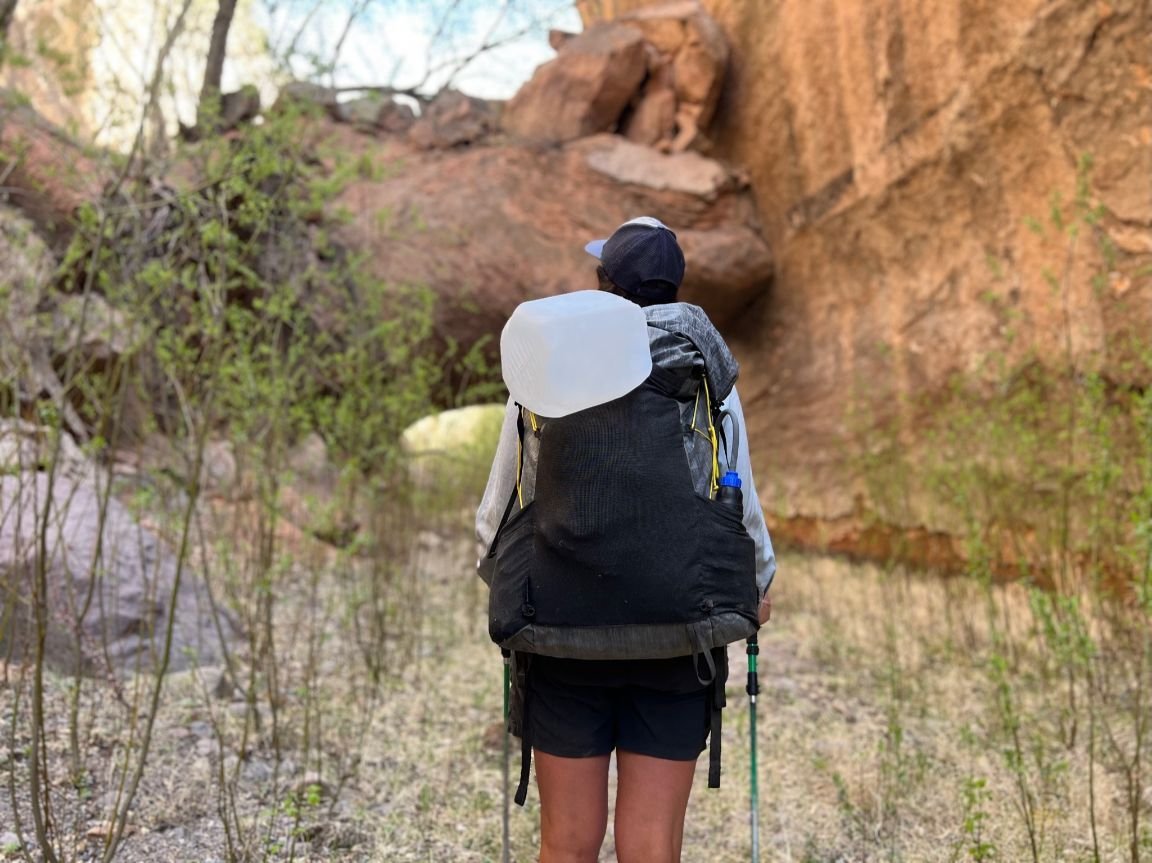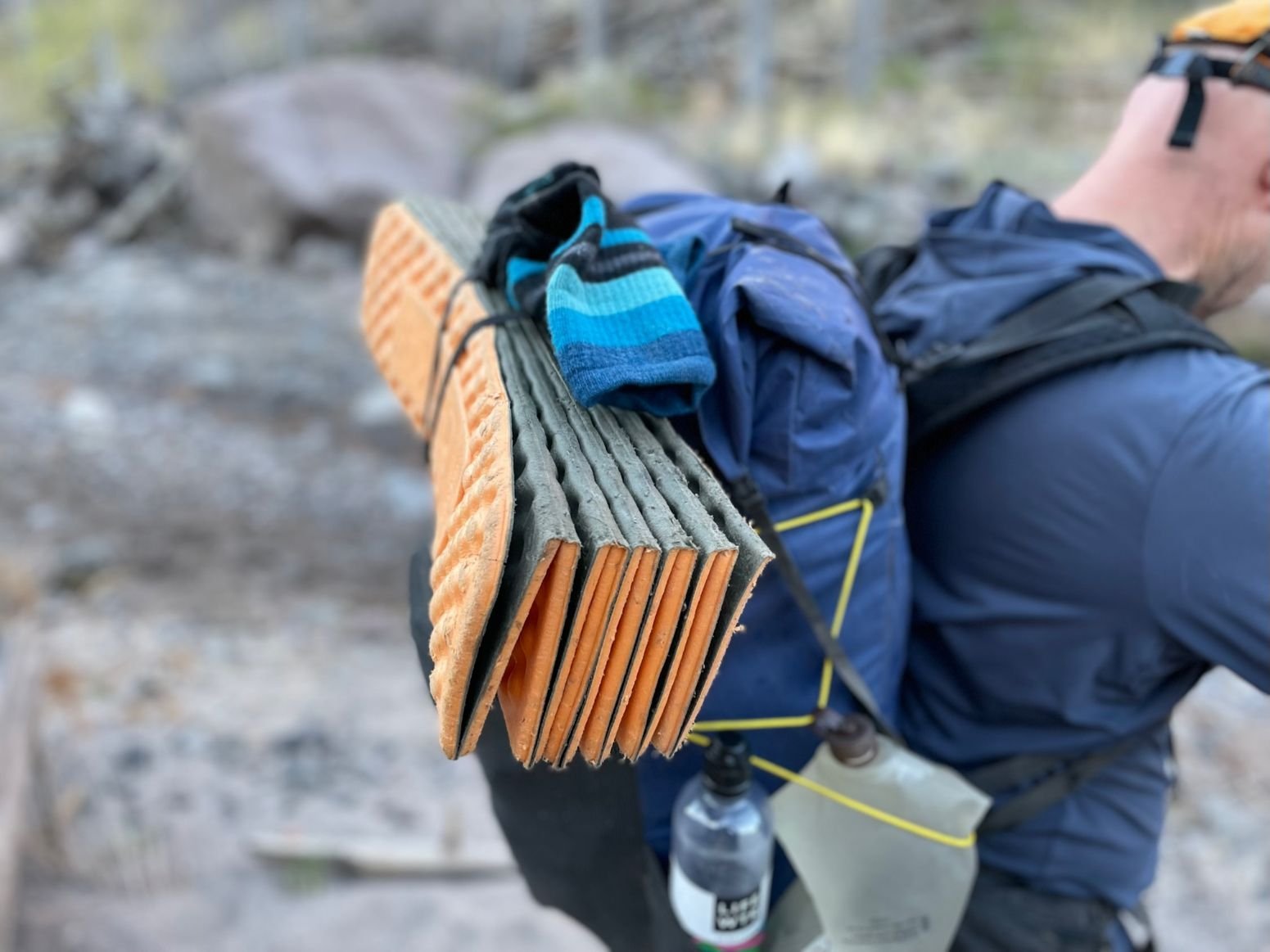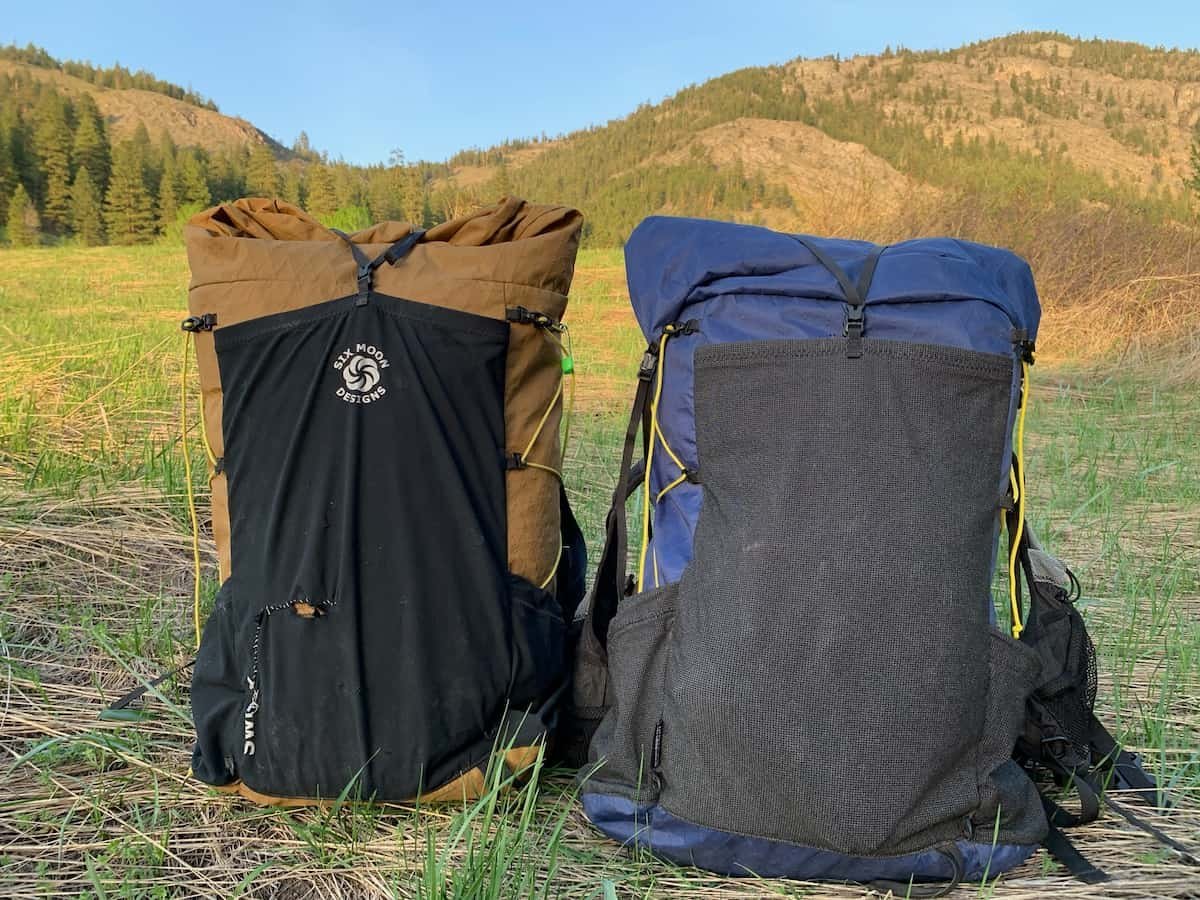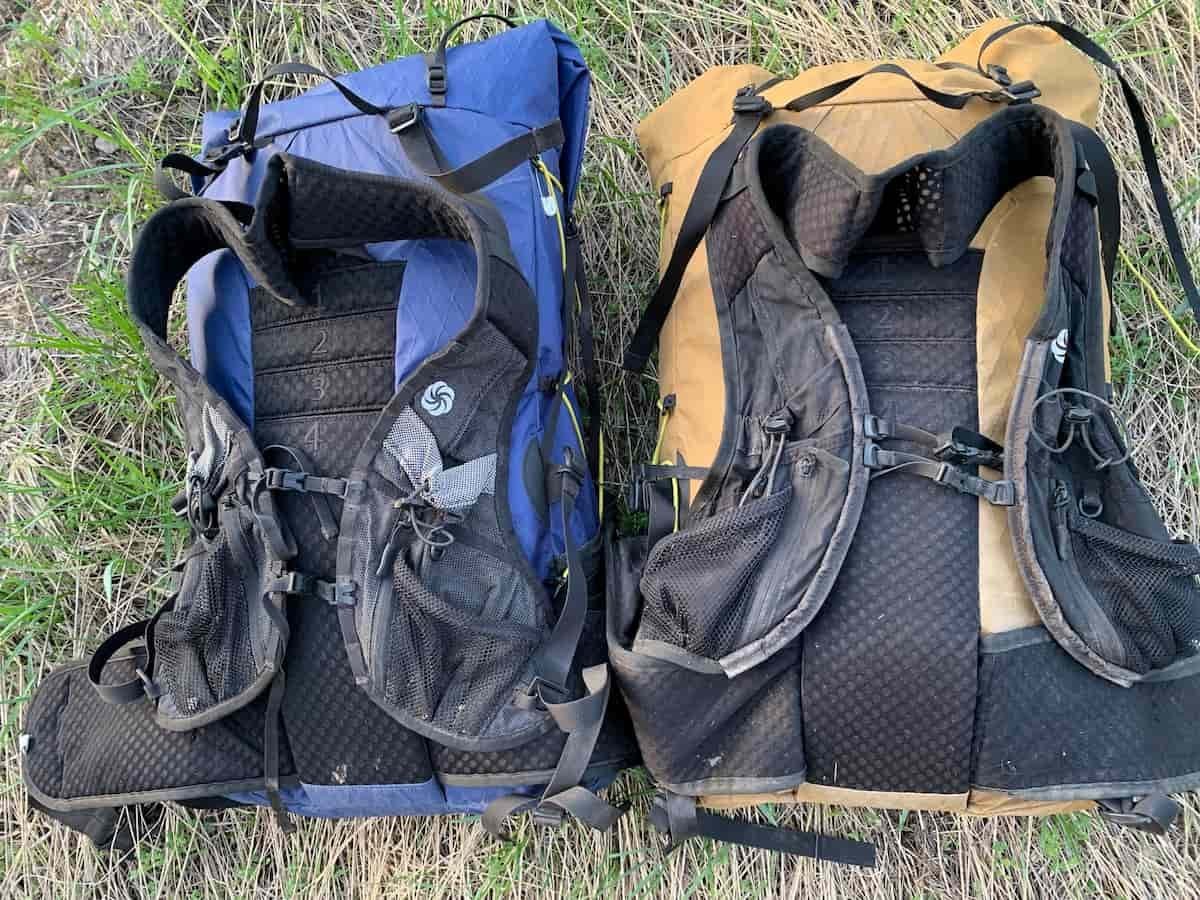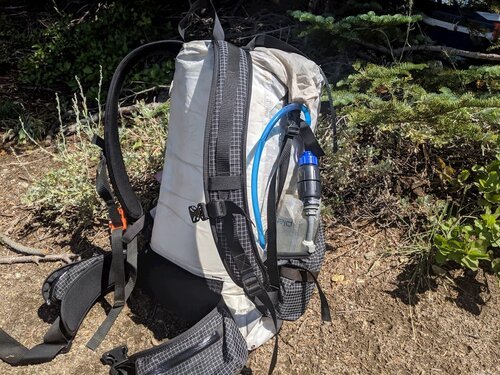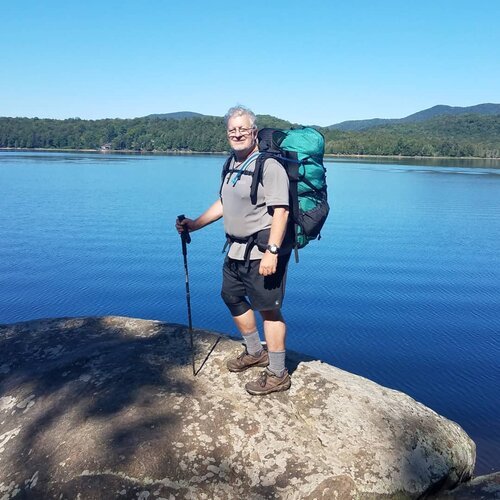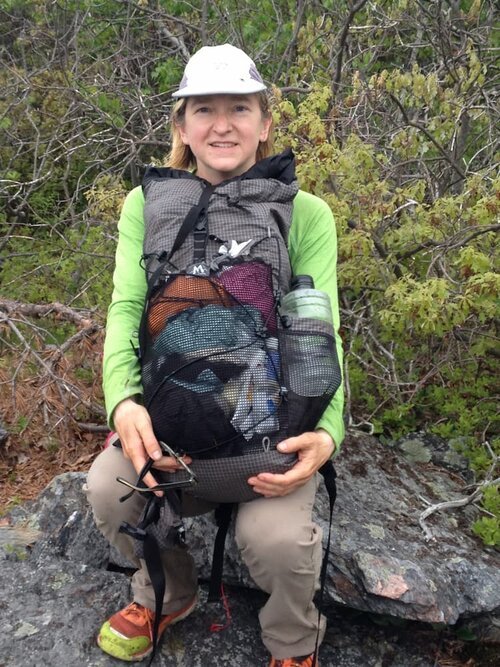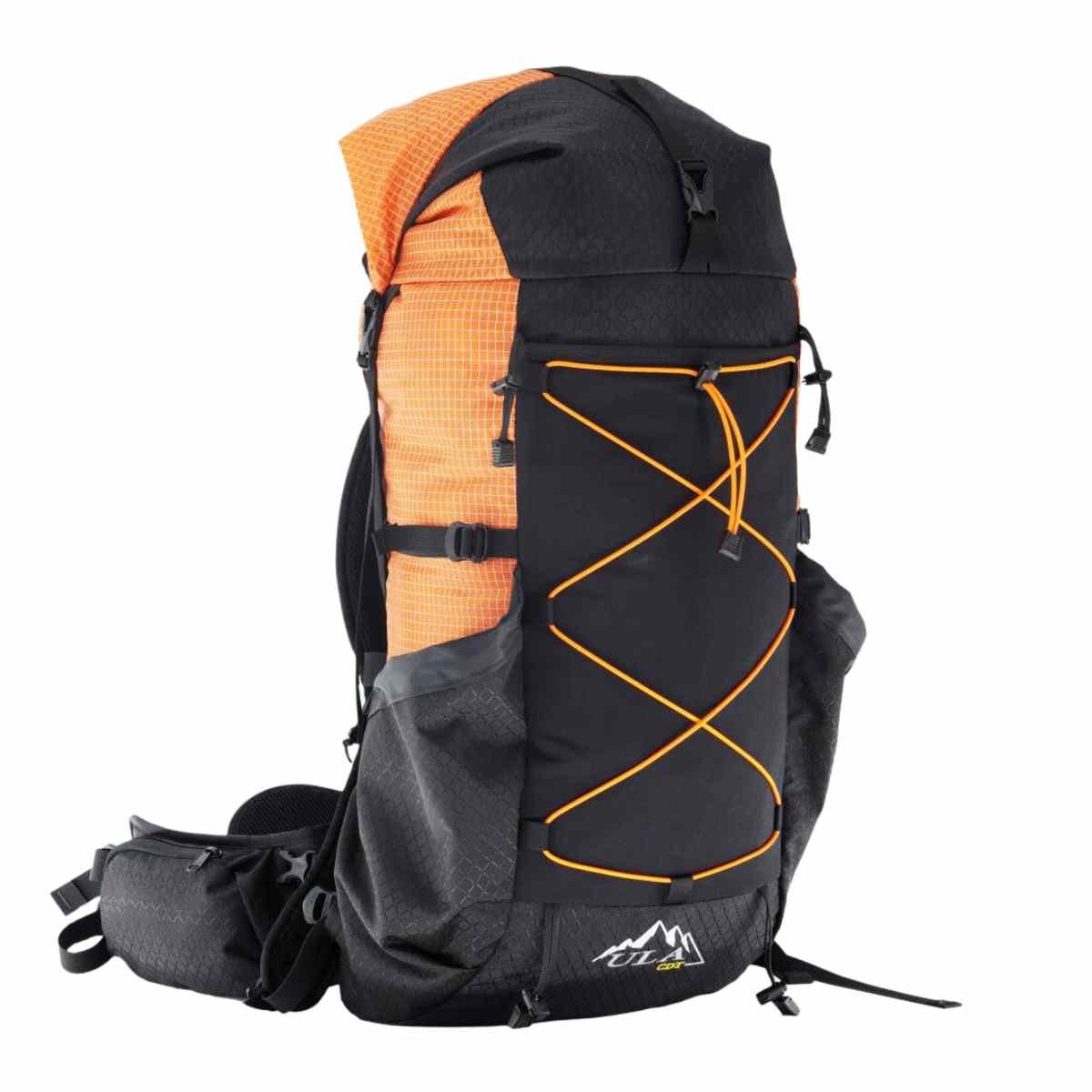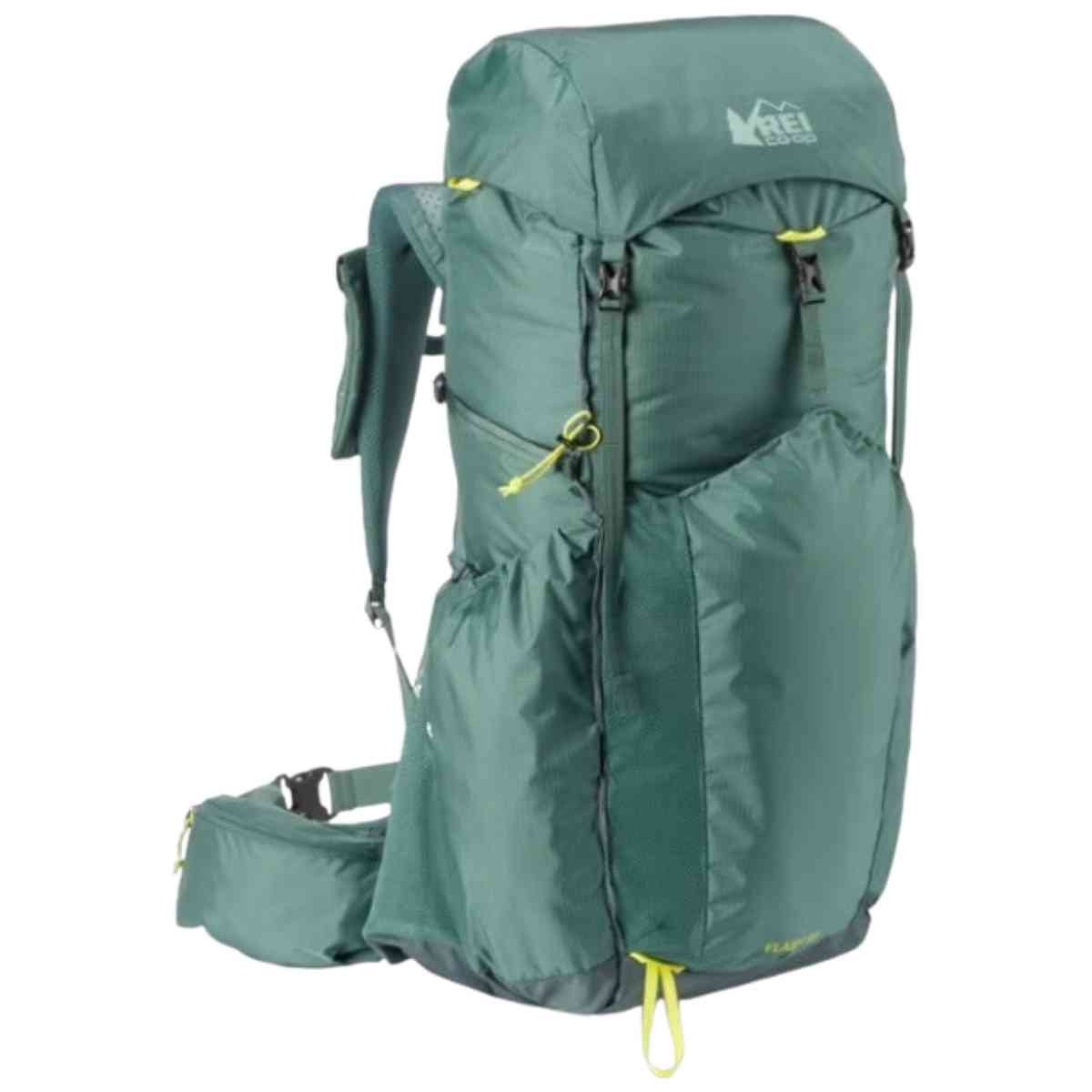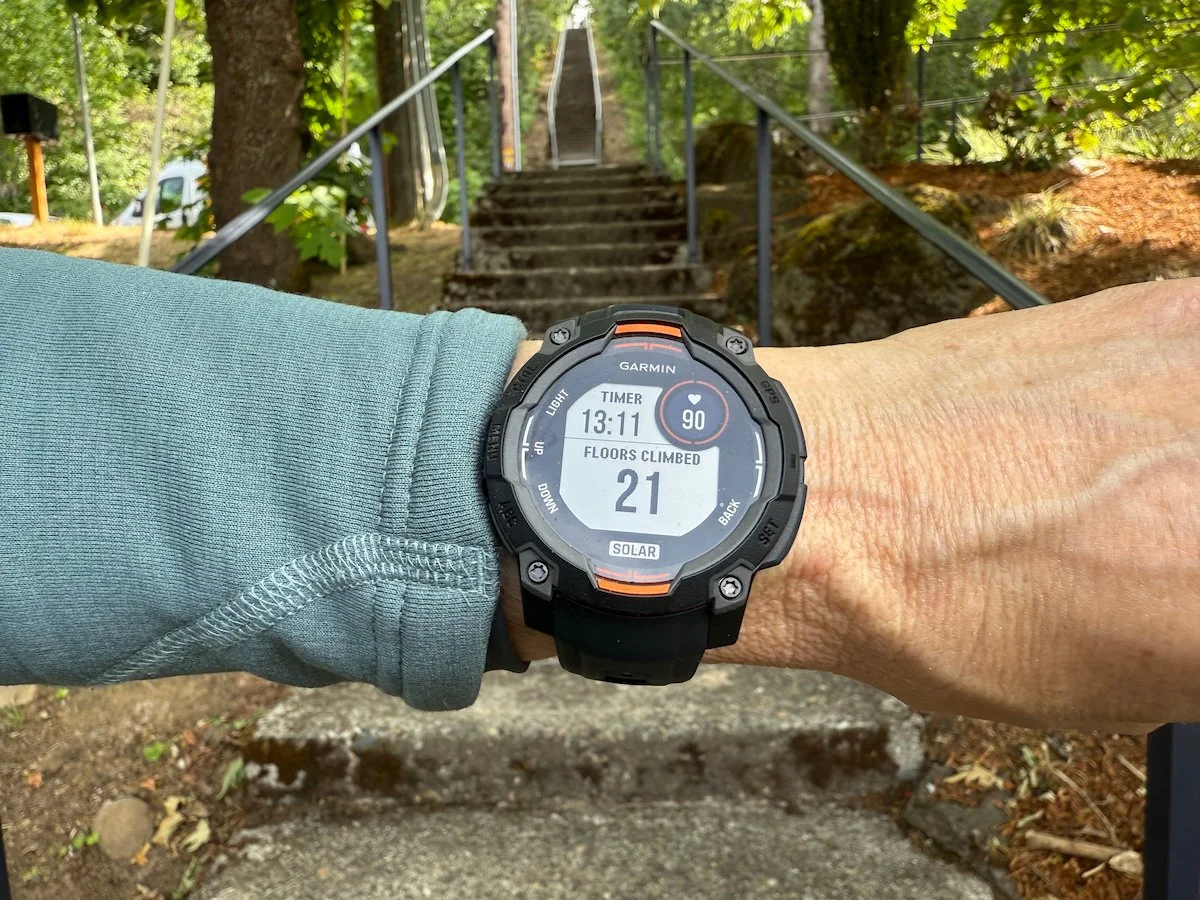Best Lightweight Backpacking & Thru Hiking Backpacks of 2024
The Top Lightweight and Ultralight Backpacks for Backpackers and Thru-Hikers
July 16th, 2024
Home > Gear Reviews > Backpacking
A backpack is arguably a backpacker’s most important piece of hiking gear. Ideally, your backpack becomes an extension of your body instead of a painful burden. Over the years, innovative backpack manufactures have revolutionized the outdoor industry. It’s no longer necessary (or desirable) to carry around a five to seven-pound backpack long distances. Now, the best backpacking backpacks weigh around two pounds and have enough carrying capacity for multi-day trips.
To identify the best lightweight and ultralight backpacking backpacks, we backpacked thousands of miles in dozens of backpacks. We also interviewed backpackers from weekend warriors to world-class long distance thru-hikers to identify the best backpacking backpacks for most hikers, looking at capacity, weight, and price.
After hiking thousands of miles testing packs, we whittled our list of 17 contenders down to the top seven backpacking backpacks specific to most people’s needs. With our advice, you’ll know how to choose a modern, lightweight backpack to serve your backpacking and thru-hiking adventures of all lengths.
We create reader-supported, objective gear reviews independently selected by our editors. This story may contain affiliate links, which help fund our website. When you click on the links to purchase gear, we may get a commission — without costing you an extra cent. Thank you for supporting our work and mission of outdoor coverage for every body! Learn more.
Backpack Comparison Table
| BACKPACKING BACKPACK | TREELINE AWARD | MSRP | VOLUME (L) | MATERIALS | WEIGHT (LBS) | MAX LOAD (LBS) |
|---|---|---|---|---|---|---|
| Six Moon Designs Swift X | Best overall Read why |
$375 | 56 | LiteSkin LS21 or EPX 200 | 2.4 | 35 |
| LiteAF Curve Full Suspension | Best for thru-hiking Read why |
$315+ | 40L or 46L | Ultra 200, Ultra X, ECOPAK, or Dyneema | 1.5 to 2.0 | 35 |
| Gossamer Gear Mariposa 60 | Best for transitioning to ultralight Read why |
$315 | 60 | 100 & 200 denier Robic high-tensil strength nylon | 2.0 | 35 |
| Hyperlite Mountain Gear Junction | Best Dyneema Read why |
$349 | 40, 55 | DCH50 (main body) and DCH 150 (bottom), or DCH150 | 1.9 to 2.0 | 40 |
| Granite Gear Crown3 60 (men's) | Best budget Read why |
$240 | 60 | Robic High-tenacity nylon (100D and 210D) with Barrier DWR | 2.4 | 35 |
Looking for a day hiking backpack? Check out our Best Day Packs for Hiking Guide
Curious about pack volume? See How Accurate are Stated Volumes of Backpacking Backpacks?
Interested in backpacking gear? See our Backpacking section for our most popular stories.
The Best Lightweight Backpacking Backpacks
Best Lightweight Backpack: Six Moon Designs Swift X
Capacity: 49L
Weight: 2.175 lbs
Cost: $375
Materials: LiteSkin LS21 or EPX 200
Max load:: 35 lbs
What we liked: carries heavy loads, lightweight for its capabilities
What we didn't like: heavier than most other packs we tested
After 1,000 miles and a year of testing, we can say the Six Moon Designs Swift X is the best overall backpack for most backpackers. The Swift X is great for those transitioning from a traditional 5+ pound pack, but also ultralight backpackers on remote routes with long food and water carries like the Oregon Desert Trail or Blue Mountains Trail. In particular, we were impressed by the Swift X’s excellent suspension system that can comfortably carry heavy loads. The Swift X offers all the utility, comfort, volume, and durability of a heavier, traditional pack — but at half the weight.
For a more in-depth look, check out our Six Moon Designs Swift X Backpack Review.
View The Six Moon Designs Swift X
The Swift X’s stand out feature is the suspension feature. Photo by Naomi Hudetz.
Suspension and fit
The Swift X’s fit and suspension system are among its stand-out features, and put it above other packs we considered. Ron Moak, the owner of Six Moon Designs, told us his packs are designed to comfortably carry any load you can fit in the backpack.
The author on the Northern New Mexico Loop with the Swift X. Side compression cords help manage the volume of the pack. You can secure items to the outside of your pack, such as for drying clothes, seen here. We recommend doing so with diaper pins so you don’t lose them. Photo by Naomi Hudetz.
The pack also has an optional innovative vest system that securely holds the backpack to your core. Another feature we like is its full set of functional and easy-to-access pockets on the pack, hip belt, and shoulder harness.
An internal Delrin hoop stay frame connects directly to the hip belt to better transfer the pack weight to your hips. We further discuss how to fine-tune your fit in our story on How to Choose Backpacks.
Testing out the Swift X on the Blue Mountains Trail. Photo by Naomi Hudetz.
Flaws but not dealbreakers
One potential downside is the Swift X is not the lightest framed backpack. The Gossamer Gear Mariposa, Hyperlite Junction, Hyperlite Windrider, and Zpacks Arc Haul are lighter. However, for a weight difference of a candy bar or two, we think the Swift X has a better suspension system and better features than these other backpacks.
Comparison of the old Swift X (left) with the new Swift X (right). The mesh has changed as well as the side pockets.
Comparison of the fit and suspension system on the old Swift X (right) and new Swift X (left).
The bottom line
Whether you’re new to backpacking, looking to lighten up from a traditional backpacking backpack, or a seasoned athlete with heavy water and food carries, the Swift X is a comfortable pack with the features you need to do what you want to do outdoors.
Best Thru Hiking Backpack: LiteAF Curve Full Suspension
Capacity: 40L or 46L
Weight: 25 to 36+ ounces, depending on fabric, size, and add-ons
Materials: Ultra 200, Ultra X, ECOPAK, or Dyneema
Cost: $330-$620
Max load: 35 lbs
What we liked: comfort, durable, secure fit, bottom pocket, side pockets, upper pockets,
What we didn't like: expensive, no hydration system
The LiteAF Curve is a great thru-hiking backpack. It is lightweight and durable, and its volume and suspension system can handle the heavy food and water carries sometimes required on thru-hikes. The Curve Full Suspension backpack is available in 40L or 46L sizes.
The Curve is one of the most customizable backpacks available. You can add a hip belt, shoulder, upper side, or bottom pockets, choose from over 40 colors or designs, and select between different top enclosure options. It comes in four torso sizes and four hip belt sizes, so you can get a near-custom fit.
The large, rugged mesh front pocket is large enough for a wet tent, rain gear, and other items needed throughout the day. The water bottle pockets can fit two bottles and are easily accessed while on the move.
The LiteAF Curve is available in UltraWeave, ECOPAK, or Dyneema. All are lightweight, waterproof, and extremely durable. The packs are seam-taped and very water resistant; however, we always recommend a waterproof bag liner.
You can customize the LiteAF Curve to meet your specific needs and hiking style. However, customization comes at a cost. Few folks will stick with the base model for $330. If you include every option, the price rises over $600.
We tested the LiteAF over 600 miles of rugged hiking in Arizona and New Mexico. We were extremely impressed with its durability – especially considering we did some bushwhacking through sharp desert vegetation. The pack still looks as good as new.
You can read more in our full review of the Lite AF Curve backpack.
The LiteAF Curve wide Y-strap securely held a 3-liter CNOC bottle on a long waterless carry. Photo courtesy Naomi Hudetz.
Best Backpack For Transitioning to Ultralight Backpacking: Gossamer Gear MariposA 60
Capacity: 60L
Weight: 1.9 lbs
Materials: 100 & 200 denier Robic high-tensil strength nylon
Cost: $285
Max load: 35 lbs
What we liked: lightweight, durable, comfortable
What we didn't like: suspension capabilities not as strong as Swift X
The Gossamer Gear Mariposa is the best lightweight backpacking backpack for making the transition to ultralight backpacking. Although the bestselling Mariposa qualifies as an ultralight pack, it offers backpackers all the utility, comfort, volume, and durability of a heavier, traditional pack at a fraction of the weight. Its intuitive, easy-to-use design and extra padding tipped it ahead of other backpacks in its weight class. The Mariposa is a multi-year bestseller for a reason, with years of data and thousands of happy ultralight backpackers and thru-hikers.
Read our full review of the Mariposa here.
Compare Prices Of The Gossamer Gear Mariposa
Treeline tester Roger hiking the Continental Divide Trail in the Gossamer Gear Mariposa backpack. Photo courtesy Roger Carpenter.
Pockets and organization
Larger than on other lightweight packs we considered, the pockets are integrated right into the hip belt. Integrated sewn-in pockets are beneficial because they won't slide or fall off should a plastic attachment come loose, as can happen with optional pocket attachments.
Large pockets are also a huge bonus when backpacking, as you can access your phone, GPS, camera, snacks, or maps without having to stop and remove your pack or use a fanny pack.
Unlike any other pack we considered, the Mariposa has three side pockets. On the right side is a water bottle pocket, big enough for two 1-liter bottles.
Above the water bottle pocket is an 8” wide x 10” tall pocket, where some people keep their cookware or other items that are voluminous but lightweight. On the left side is an 8” wide x 16” tall pocket that would be great for a small tent (we were able to fit a Zpacks Duplex tent without its stuff sack into this pocket).
The Mariposa is secure and balanced for when you travel on uneven ground. Photo by Liz Thomas
Adaptability
The hip belt, frame, and sit pad (back support) can be easily removed converting the pack into a frameless pack weighing close to one pound.
Flaws but not dealbreakers
One minor issue is that there is not a great place to hold a full-size umbrella (popular with many hikers for sun and rain protection). The umbrella will fit in the large side pocket, but there is no side compression strap or cord to secure items that stick out above the pocket.
The bottom line
For its comfort, features, easy organization, and spaciousness, the Gossamer Gear Mariposa is a great choice for backpackers headed on their first thru-hike.
Best Dyneema Backpacking Backpack: Hyperlite Mountain Gear JunctioN
Capacity: 50L
Weight: 1.88 lbs
Materials: White: DCH50 (Main Body) & DCH150 (Bottom)
Black: DCH150 (Main Body & Bottom)
Max load: 40 lbs
Cost: $349
What we liked: overall durability, water resistance
What we didn't like: issues with durability of the mesh
The Hyperlite Mountain Gear Junction is the best Dyneema backpacking pack available because of its balance of quality, durability, and water resistance. Hyperlite Mountain Gear is a small, outdoor gear manufacturer in Maine. We found that HMG backpacks are made with an attention to detail that makes it worth paying a premium for their gear. The ultralight Junction backpacks — available in 40L and 55L sizes — became our Dyneema winner because of their ease of use and well-designed pockets.
Read our full review of the HMG Junction.
View The Hyperlite Mountain Gear Junction Backpack
Junction 40
junction 55
The HMG Junction backpack at Kearsarge Lakes in the Sierra. Photo by Naomi Hudetz.
Material
While not everyone will want a backpack made of Dyneema Composite Hybrid (DCH, formerly known as cuben fiber fabric), many backpackers find it to be a top priority. DCH is a rugged sailcloth that is abrasion-resistant and waterproof enough to be the fly on a three-season tent. Despite being waterproof, we strongly recommend you use additional methods to protect your gear. See our section on how to keep your gear dry.
While HMG is not the first backpack manufacturer to use the DCH fabric, they do more volume in DCF and DCH backpacks than any other company. That volume has allowed HMG to refine the process to an art.
The HMG Junction on the PCT near Mt. Ashland. Photo by Liz Thomas
The HMG Junction has DCH fabric lined side pockets and generous hipbelt pockets for storage. Photo by Liz Thomas
Design
The similar HMG Windrider and Southwest have been ultralight thru-hiker standards for several years. After testing different models on a thru-hike of the Ouachita Trail, we compared and think the Junction is the best. Here's why: The Junction’s design is a combo of the best of the Southwest and Windrider — and before it existed as its own model, a design similar to the Junction was one of the most popular custom design requests.
Comfort
HMG packs are designed to carry comfortably without load lifters, which is a point of contention among hikers. Some hikers — even lightweight or ultralight hikers — find a benefit to load lifters, saying they prevent shoulder knots and bruising. Others think they’re a relic of traditional backpacking backpacks. If you know you like load lifters, try the HMG pack fully loaded in your house before committing to it (don't worry — they have a great return policy).
The bottom line
We think the HMG Junction is the best Dyneema pack for most backpackers. While not everyone wants or needs a Dyneema pack, HMG has perfected the art of working in this fabric to create a pack that will serve you well on the long haul.
Best Budget LIGHTWEIGHT Backpack: Granite Gear Crown3 60
Capacity: 60L
Weight: 2.36 lbs
Materials: Robic High-tenacity nylon (100D and 210D) with Barrier DWR
Cost: $240
Max load: 35 lbs
What we liked: options to adjust weight, lots of features, great value for the price, undyed fabric available as an eco-friendly option
What we didn't like: doesn't use PFC-free DWR
Granite Gear Crown3 60 is an excellent lightweight backpack — and at about $240 (and often found on sale for less), is a great value. The Crown3 has 60 liters of capacity, a 35-pound load rating, and weighs less than two and a half pounds. Despite its light weight, it has many of the features found in a traditional five-pound backpacking pack, including a plastic internal frame and well-padded shoulder straps. Best yet, with so many removable features, it is easily adaptable.
Treeline Review editor Liz Thomas used this pack in the undyed fabric for a thru-hike of the ~330-mile long Superior Hiking Trail and found it had all the comfort and features she wanted in a backpack at a fraction of the price of other lightweight pack brands.
Compare Prices Of The Granite Gear Crown3 60
Men's
Women's
The Crown3 60 is available in men’s and women’s versions. The women’s version is sized to fit hips and curvier bodies. Photo courtesy Liz Thomas.
Adaptability
Our favorite feature of this pack is that as you learn to backpack with less weight, you can adapt this pack to be lighter. If you are interested in ditching the old five-pound pack and trying a more lightweight approach to multi-day backpacking, this could be the perfect pack.
The Crown3 50 has the same generous mesh that can fit a multi-day food supply just on the outside of the pack. Here, the pack is shown without the pack lid. Photo courtesy Liz Thomas.
Fit and comfort
The Granite Gear Crown3 60 is one of the only packs we reviewed that come in men's and women's designs to better conform to different body shapes and sizes.
The Crown3’s shoulder straps — slightly different on the men’s and women’s versions — are wide and thickly padded. The Crown3 uses a molded plastic frame sheet that is integrated with the hip belt to transfer weight to your hips. There is also a foam back panel that is molded to allow airflow to reach your back. We were happy to see the Crown3 60 has load lifters for a more comfortable carry.
Pockets and organization
The Crown3 has a lid with a large zippered pocket. For those looking to reduce weight on their pack, the lid can be removed to reduce the pack’s weight by approximately two and a half ounces.
With the lid removed, the main compartment features a roll-top opening with a buckle closure that is able to accommodate different volumes. For example, we've used Crown360 on a backpacking trip with a 135-mile section without resupply. We've also used it on shorter day hikes. The many options for straps means it folds up and scrunches down to whatever size you need.
The bottom line
The Granite Gear Crown3 60 is a much-beloved pack that is easy on the wallet, and can take a lot of love on the trail.
Best water resistant backpack: ZPACKS Arc Haul UltrA 60L
Capacity: 60 L
Weight: 1.31 to 1.39 lbs (depending on size)
Materials: Ultra 100, Ultra 200, mesh, 3D spacer mesh
Cost: $400
Max load: 40 lbs
What we liked: light weight, frame carries weight well, waterproof material
What we didn't like: price, limited colors, pockets are extra
The Zpacks Arc Haul Ultra 60L backpack is made from Ultra 100 and 200, and at 1.34 lbs is perhaps the lightest mid-size volume pack on the market with a frame. It's our top choice for best water-resistant backpack with an extremely water-resistant material and full-seam taping. We've used some version of this pack on thru-hikes in the wettest conditions without a packliner (but we don't advise this). It's an excellent pack on its own merit, and its waterproofing abilities make it the best lightweight pack choice for wet conditions.
We love the Arc Haul for its light weight and Curved Carbon Fiber frame system which allows airflow to the back. The roll top closure adds additional security from wet conditions, and the pack has efficient pocket and strap features that let you customize exactly what you need.
View the ZPACKS ARC HAUL Ultra 60L
Treeline editor Liz Thomas thru-hiked the Arizona Trail southbound in October carrying the ZPacks ArcHaul.
Water resistance
The Zpacks Arc Haul Ultra is an update from the previous version, the Zpacks Arc Blast. Our testers used the Arc Blast for thru-hikes of the Pacific Crest Trail and two thru-hikes of the Great Divide Trail in the Canadian Rockies. On our first thru-hike of the Great Divide Trail, it rained or snowed for 37 of 40 days on trail with the carwash effect (wet bushes) leaving us sopping wet for almost the entire trip. The Arc Haul kept everything dry, even without a liner.
We did further "lab" testing of dunking this fully loaded pack into a Sierra alpine lake with our sleeping bag (unprotected) inside. We also sprayed the Arc Blast with a hose for a minute straight. In both cases, the Arc Haul delivered.
Note: We always recommend using a packliner, even on waterproof backpacks. But with the Arc Haul, you can go for the most minimalist packliner possible, the Nylofume.
The ArcHaul is a sturdy pack that could handle the heavy and long water carries of the Arizona Trail with its comfortable frame.
Comfort
We tested the newer Arc Haul Ultra on a fall thru-hike of the Arizona Trail. It's comfortable and well balanced, holding the weight of the long water carries through the desert. Admittedly, the Arizona Trail wasn't the wettest hike for testing waterproofing, but when it rains and snows in Arizona, it really does let loose.
The bottom line
If you're willing to spend extra for the security and extreme light weight, the Zpacks Archaul is a time-tested pack and thru-hiker favorite.
BACKPACK WITH BEST VENTILATION: Osprey Exos Pro & Osprey Eja Pro 55
Capacity: 55 L
Weight: 2.08 lbs
Materials: recycled 100-denier high-tenacity nylon ripstop (bluesign approved)
Cost: $290
Max load: 30 lbs
What we liked: comfort of the carry on the suspension system, well-ventilated to reduce sweaty backs, bluesign approved fabric with PFAS-free DWR, Osprey lifetime warranty
What we didn’t like: side pocket height, lack of stretch front pocket, durability, frame height prevents neck movement and wearing wide-brimmed hats
The Osprey Exos Pro 55 is the men’s version and the Osprey Eja Pro 55 is the women’s version of the same pack (note: the Eja, size medium weighs 2.82lbs). Our favorite thing about these packs is the ventilation offered by the AirSpeed suspension system that keeps the pack off your back. This is the only lightweight pack we tested that has a drastically curved back. This allows for more airflow and less sweating. That's why we think the Osprey Exos and Eja is the best ultralight pack for people who want more ventilation in their backpacking backpack.
Backed with Osprey's impressive lifetime warranty, this is a lightweight pack with comfort, ventilation, and many features and the latest version is an improvement on a long-time backpackers' favorite.
For an in-depth look at this pack, check out our detailed review of the Osprey Exos Pro and Osprey Eja Pro, where we cover its features, performance, and overall comfort on the trail.
Compare Prices Of The Osprey Exos Pro & Osprey Eja Pro 55
Men's (EXOS PRO)
Women's (EJA PRO)
The Osprey Eja Pro on a backpacking trip in the Sierra.
Ventilation
One of our testers has backpacked and thru-hiked extensively with ultralight packs and has always found his back covered in sweat. He tested the Exos in the Mojave Desert and had an "ah ha" moment. He found it to be comfortable and could feel a breeze against his back. He fully admits that it doesn't mean his back wasn't sweaty (it still was) but that this was the coolest he's felt with a backpack. This pack is a comfortable option for folks who sweat a lot and want the best ventilation possible.
Comparison of the Osprey Aether 60 (left) with the minimalist Osprey Eja Pro 55 (right). Both are fully loaded for an overnight backpacking trip in Anza Borrego Desert.
Weight
With the Exos and Eja Pro, Osprey shaved nearly a pound off the previous versions, but still maintains an impressive list of features, including a mesh back panel and yoke, a removable brain, a hydration sleeve, and deep pockets.
The deep mesh side pockets can hold a full insulated water bottle and tent poles. You can see the dual access point on the right where the blue tent poles are more visible. Here, we’re on a trip in the San Gabriel Mountains National Monument.
Flaws but not dealbreakers
Our one issue with this pack is the front pocket is reinforced with ripstop fabric, which means it isn't as stretchy as front pockets that only use mesh. The fabric used on this pack is also thinner than others and while we haven't had any issues, we do worry about the long-term durability. Backpackers have hiked the PCT and other long trails with this pack, but we do not recommend this model for folks tough on gear.
BEST LARGE CAPACITY BACKPACK: ULA CATALYST
Capacity: 75L
Weight: 2.92 lbs
Materials: ULA 400 Robic
Cost: $300
Max load: 40 lbs
What we liked: high weight and volume capacity, great for backpackers with kids
What we didn't like: heavier than other packs tested
Sometimes you need to carry a large volume—even if it isn’t that heavy. Guides, troop leaders, or folks with children may have to carry extra food, first aid kits, or other people’s gear. The ULA Catalyst has a 75-liters capacity and a 40-pound load rating — but only weighs 3 pounds.
The Catalyst was the most popular and highest rated pack among Pacific Crest Trail (PCT) hiking class according to the annual survey of PCT hikers.
You can read more in our in-depth, long-term review of the ULA Catalyst backpacking pack.
View The ULA Catalyst
The ULA Catalyst has the capacity to carry a bigger volume than almost all the packs we recommend, which means it is well-suited for use on winter trips. Photo by Eric Weeks.
Volume and capacity
We liked the Catalyst because it’s a lightweight backpacking pack that is specifically designed to take bigger volumes and somewhat heavier loads. The ULA Catalyst is a full-featured pack designed for folks who want to haul bulkier items such as fishing gear, extra camera equipment, or large food carries.
Treeline Review reader Phil Hough in the Adirondacks with his ULA Catalyst. He hiked the Trans Adirondack Trail with this pack, appreciating its volume to carry longer food carries and equipment. Photo courtesy Phil Hough.
Best uses
We also have found the Catalyst to be a good choice for lightweight backpackers with kids who may want to carry some of their children’s gear. Several of our writers use the Catalyst while backpacking with kids.
We've even had readers write in to tell us they use it when they've had to backpack with extra medical equipment. The capacity and carry of this pack are great, especially for an ultralight backpack.
The ULA Catalyst has a mesh pocket as well as suspension cord. Note the slanted side pockets, which make it easier to access water bottles. Photo by Eric Weeks.
Bear can
The Catalyst can fit a full-size bear canister both vertically and horizontally (another reason it’s popular with PCT thru-hikers). In contrast, our top backpack pick, the Six Moon Designs Swift X, can only fit a bear can vertically (although it can be strapped to the top horizontally on top of the pack). The ability to carry a bear can is essential for traveling through national parks, like Yosemite, and through the Sierra and Adirondacks.
Max load
Despite the Catalyst’s ability to take larger volumes, it’s only rated to 40 pounds. This means it is well-suited for you if you’re carrying your own gear plus large volume items that tend to not weigh much.
The bottom line
We like the Catalyst for winter hiking or shoulder season hiking, where we find ourselves bringing a lot of lightweight but bulky down items. A 10-degree sleeping bag takes up a lot more volume than a 30-degree bag, even if it only weighs a few ounces more. Similarly, warmer down jackets or synthetic jackets can be bulky. These are the situations where the Catalyst excels.
THE BEST FRAMELESS BACKPACKING BACKPACK: MOUNTAIN LAUREL DESIGNS PROPHET 48L
Capacity: 48L
Weight: 1.06 lbs
Materials: 2023 UltraWeave X 200/100( Gray+Black), UltraGrid 200d RipStop (Black Beauty, Red Chili, or Avocado)
Cost: $325
Max load: 25 lbs
What we liked: light weight, durability
What we didn't like: small company means possibly long wait times
Frameless backpacks are not for everyone. But if you’re an ultralight backpacker who has reduced your base weight below 10 pounds, we think the Mountain Laurel Designs (MLD) Prophet 48 L is the best pack you can get.
Our writers and editors own multiple frameless packs, and the Prophet is our favorite. I purchased and own both the Dyneema X and DCF versions of the MLD Exodus. I can attest to the quality and durability of MLD packs. My Dyneema Exodus has over 5,000 miles of use. It weighs about a pound, it’s very well made, it’s customizable, and it has the perfect volume for multi-day, lightweight adventures.
View the Mountain Laurel Designs Prophet 48L
The MLD Prophet’s mesh pocket has abundant room for items you want to easily access. Photo by Mike Unger.
Volume
Our writers and editors own all three sizes of MLD packs in this line. After some discussion, we collectively recommend the MLD Prophet (the middle size) because we believe it’s the perfect size for most folks transitioning to a frameless pack.
The author scrambling unsteady boulders on the Appalachian Trail near Lehigh Gap with the MLD Exodus, the 57 L version of the 48 L Prophet. Photo by Naomi Hudetz.
Max load
We’ve found that MLD’s description that the Prophet comfortably fits “loads up to 25 pounds” is accurate. The pack holds up when carrying loads heavier than 25 pounds, but it’s not comfortable.
Design
Although the MLD Prophet is a simple, minimalist ultralight pack, it has a number of innovative features like curved side panels, S-shaped straps, actually good hipbelt pockets, and generous side pockets and front pocket.
The MLD Prophet has straps to secure an umbrella, and a generous mesh to store snacks and essential items on the outside of the pack. Photo courtesy Liz Thomas.
Customization
MLD offers a number of options to customize your pack. And if you have special requests, MLD will work with you to further modify your backpack. For instance, many ultralighters with very low base weights will have MLD remove the hip belt.
Flaws but not dealbreakers
One major downside of the MLD is that they’re a small company — meaning they often have a waiting period, as your pack is often made to order. If you need your pack sooner than the waiting period, we suggest the ULA CDT as a frameless ultralight backpack option that’s usually in stock
Not sure whether to get a frameless backpack? Here’s our take on how to decide whether it’s a good idea to go frameless.
Other Packs we Considered
In preparing this article, we considered many other excellent backpacks. Below is a list of some of the other backpacks we considered that we would recommend, but ultimately did not choose as our top picks.
ULA CDT
Capacity: 54L
Weight: 1.56 lbs
Materials: ULA 400 Robic
Cost: $200
Are you frameless curious, but don’t want to spend $300+ for a fully-loaded MLD Prophet? The ULA CDT is a great option. We carried the CDT on a thru-hike of the Appalachian Trail and found it lightweight, durable, with enough features to make it an excellent bang for the buck ultralight option. The ULA CDT is the Best Budget Frameless Backpack.
The CDT has over 50 liters of volume (slightly more volume than the MLD Prophet, our overall Best Frameless Pack winner) and only weighs 24 ounces. The best part is that it costs $145, about half the cost of the MLD Prophet, and has some add-on features. The ULA CDT has a recommended maximum load of 18 pounds — 7 pounds less than the MLD. Therefore, this pack is only recommended for folks with a sub-10-pound base weight (so all your stuff minus food and water is less than 10 pounds).
View The ULA CDT Backpack
The CDT is well-suited for shorter backpacking trips or longer trails that don’t require very long resupply sections. Photo courtesy Liz Thomas.
FEATURES
The ULA CDT is a full-featured frameless pack capable of multi-day adventures. The following is a list of pack features:
Internal pad holster and thin foam pad
This will provide some minimal back cushioning, but should not be considered a frame. Like all frameless packs, a sleep pad can be used to provide more cushioning.
Contoured and padded hip belt and shoulder straps
Large sewn-in hip belt pockets
We prefer sewn-in hip belts to detachable ones as they tend to ride better and won't dangle or sag.
Adjustable side pockets
Adjustable side pockets mean you can secure your items depending on what you are storing inside.
A sleeve for your water bladder
This protects your gear from your water reservoir and also keeps it in the correct position to keep water flowing through the hose.
Internal stash pocket
This is helpful for securely storing keys and your wallet, which you probably won't need in the wilderness but will definitely need to carry for when you return.
Water bottle holsters
Some hikers find that keeping water bottles in holsters allows for easier access. The water bottle holsters come standard on this pack.
The ULA is an affordable, durable, and compact frameless pack. Photo by Whitney LaRuffa
Hand loops
These are loops attached to the shoulder straps where you can hang your hands if you’re not using poles and don’t want your hands to swell. If you, like me, would never use hand loops, they can be removed to save about one ounce of pack weight.
CUSTOMIZABILITY
ULA also offers a number of options to customize your pack:
You can choose a roll-up closure for the top of the pack instead of the standard cinch-top
You can choose “J” or “S” curved shoulder straps. “S” curved straps are designed to go around instead of directly over one’s chest. According to ULA, “J” straps work best for men with average builds; “S” straps work best on almost all women and men with square shoulders and good posture. ULA encourages folks to contact them if you have fitting questions. They are able to customize shoulder straps.
You can skip the hip belt (and save $10)
There are nine pack colors to choose from. For a cost, ULA will even let you select a different color for every part of the pack
You can even have your name embroidered into the pack (this costs an extra $15).
Capacity: 68L
Weight: 2.65 lbs
Materials: Ultra 100, Ultra 200, mesh, 3D spacer mesh
Cost: $400
The ULA Circuit has been a favorite of long-distance hikers for years. In fact, we like it so much we wrote a long-term, in-depth review of the Circuit.
We chose its larger sibling, the Catalyst, as our winner for best large capacity pack. The Catalyst has a more substantial frame system and is a better choice for heavier loads.
The ULA Circuit is a great pack and an excellent value with many of the same benefits as the Catalyst: it’s made in the USA and incredibly customizable.
Ultimately, we preferred the Swift X’s vest harness system and pockets. We tested the Swift X in Xpac and preferred that to the Robic material of the Circuit. However, ULA recently released a new model of the Circuit in Ultra. We haven't tested the model in that material yet, but it looks promising.
Even in Robic, we think the Circuit is an excellent choice for a backpacking pack for folks who want something in the 68L capacity size.
View The Ula Circuit
REI FLASH 55
Capacity: 55L
Weight: 2.63 lbs
Materials: 100-denier and 210-denier recycled nylon Robic ripstop
Cost: $199
The men’s and women’s REI Flash 55 is a good value at under $200. It was even a contender for our budget pick. However, we chose the Granite Gear Crown3 60 over the Flash 55 because it has a larger volume, a higher load rating (30lbs vs. 35lbs), and it’s several ounces lighter. We’ve also seen the Flash have fabric durability issues, where the Granite Gear can sustain multiple thru-hikes of use and abuse. Customer reviews in particular took issue with the sewing quality on the Flash, especially around the shoulder straps. We think if you want a light backpack that is affordable, the Granite Gear Crown3 60is a better option.
View The Rei Flash 55
MEN'S
WOMEN'S
Capacity: 50 L
Weight: White: 1.9, Black: 2
Materials: White: DCH50 (Main Body) & DCH150 (Bottom), Black: DCH150 (Main Body & Bottom)
Cost: $349
The Hyperlite Mountain Gear Southwest 40 is designed for overgrown backcountry excursions, places with thick vegetation, anywhere your pack might take a beating. It’s lightweight and durable. We used this pack on a thru-hike of the Ouachita Trail. It’s not the most comfortable and could use a little tweaking with pocket size and placement, but overall this is a reliable lightweight backpack. Still, we think pocket placement on the Junction is better.
The major advantage of the Southwest over the Junction is the distribution. The Southwest has become widely available. You can get it at Backcountry or REI and you can take advantage of REI's great return policy if things don't fit right.
Compare Prices Of The Hyperlite Mountain Gear Southwest 40
Capacity: 40, 55 L
Weight: 1.9 lbs
Materials: DCH50 (main body) and DCH 150 (bottom), or DCH150
Cost: $349
We tested the Hyperlite Mountain Gear (HMG) Windrider on the thru-hike of the Ouachita Trail (see our Trip Guide to the Ouachita Trail). Like the Junction, it’s also available in 40 and 55L volumes, as well as a 70L volume.
The main difference is that the Windrider uses mesh for the front and side pockets whereas the Junction uses mesh in the front pocket only. We prefer the stronger DCH fabric for side pockets. It’s a minor quibble, but the sides are an area of the pack that is susceptible to rubbing against brush on narrow trails. The fabric found on the Junction adds some durability and more secure storage space.
The major drawback of the Junction compared to these other HMG packs is distribution. The Windrider is available at Backcountry, whereas you can only get the Junction at HMG’s website or Garage Grown Gear.
View the Hyperlite Mountain Gear Windrider 40
Capacity: 56 L
Weight: 2.25 lbs
Materials: Robic Nylon
Cost: $275
The Six Moon Designs Swift V Hiking Backpack is a budget-friendlier version of the Swift X. By using Robic nylon fabric, this backpack cuts costs while maintaining the design and features of our selection for Best Overall Lightweight Backpacking Backpack, the Swift X. This model has been updated with deeper and stretchier pockets, as well as two additional side straps for securing the roll top closure.
Compare Prices Of The Six Moon Designs Swift V
A line up of some of the packs we tested for this story. Photo by Mike Unger.
Buying Advice: What To Look For In A Backpacking Backpack
To decide on our winning backpacks, we set the following criteria. All the packs we considered met these criteria, including our runner-ups.
You can read more about each of the criteria, how to choose a backpack for your hike, how to fit a backpack, and keeping your gear dry visible in our article How To Choose Backpacks.
Pack Weight
All of our recommended backpacks weigh less than three pounds. In the past, packs of such low weights may have seemed extreme. Now, we believe technology has advanced such that there are exceptional backpacks with plenty of capacity for most backpackers that weigh under three pounds. Most of the packs we recommend are not for mountaineers, alpinists, climbers, ski tourers, or people who need to carry extremely heavy loads of gear. They are for folks who want to enjoy the outdoors on an overnight or multi-day hiking trip.
Carried Weight/Load Limit
For our Overall, Dyneema Winner, and Budget picks, we considered packs that can comfortably carry 35 pounds. For our Large Capacity winner, we considered packs that can comfortably carry 40 or more pounds. For our frameless pack picks, we considered packs that can comfortably carry 20 pounds. We think this weight reflects what most people can carry while backpacking.
Pack Volume
With the exception of the Best Large Capacity pack, the packs we considered can carry 50-68 Liters.
Essential Pockets
While the quality, size, and secureness of pockets differ, all the packs we considered have the following pockets: hip belt pockets, a mesh front pocket, and water bottle pockets. We find these pockets essential to finding and accessing everyday items much easier for backpackers.
Can Fit A Bear Can
Many National Parks require backpackers to carry a bear can. That’s why we think that if you’re only going to buy one backpack, the pack that you carry should be able to fit a bear can. This doesn’t mean that your backpack needs to be huge. It just means that the opening hole to get inside your pack is wide enough to fit a wide diameter.
Attachment Points
All the packs we considered must, at minimum, have an ice axe loop. Having this feature makes it much easier for you to carry an ice axe and thus, make safe decisions when traveling in snowy conditions.
The Gossamer Gear Mariposa on the Sierra High Route. Photo by Liz Thomas
Durability
The packs we tested are made from lightweight, durable materials, like nylon, LiteSkin, Ultra, and Dyneema. These are some of the strongest, longest-lasting materials you can find in a backpack, without packing on a ton of weight. Outside of the primary material for the bulk of the pack, mesh pockets and spacers for breathability can also affect the durability of the pack (some mesh is more durable than others), so it’s helpful to read reviews to look out for issues with the mesh before purchasing.
Comfort
You’re likely going to be investing a lot of time, miles, and energy in this pack, so you want to be as comfortable as you can be. This is particularly important at the shoulders, hips, and lower back, which means straps, torso size, and hip width may all play a factor in your buying choice.
Waterproofing or Water Resistance
Depending on where you’ll be backpacking and what the weather conditions are likely to be like, water protection may be an important factor for you. Packs made from materials like Dyneema, X-Pac, ECOPAK, and LiteSkin are going to repel water best, though that won’t protect exterior mesh pockets of course. Roll top closures and taped seams are also better waterproof methods than extension collars and stitched seams.
CLOSURE SYSTEM
There are a variety of closure systems for backpacking packs, including roll tops, zippers, drawstrings. Roll tops and YKK zippers are better waterproof options, but if waterproofing isn’t a priority for you, any of the closure systems should work just fine.
We tested the Zpacks ArcBlast on the Great Divide Trail through 40 days of rain, snow, and sleet. Photo by Liz Thomas.
Ventilation
If you sweat a lot, ventilation may be a priority for you. Suspension systems with mesh barriers between your back and the pack improve air flow. While it doesn’t guarantee a dry back at the end of the day, it does reduce the amount of sweat that collects between your body and the pack.
Back panel padding
Back panel padding foam is added to the back of packs and shoulder straps for comfort, breathability, and weight distribution.
Materials
The materials used to construct backpacks impact its durability, weight, water resistance, and quality. We tested packs that primarily used nylon, Dyneema (DCF), Ultra, and LiteSkin. Packs also commonly use mesh for exterior pockets and ventilation.
Tips for packing a lightweight backpack
Packing a lightweight hiking and backpacking backpack requires some planning and careful selection of what gear you bring. With a lightweight pack, your goal is to balance weight and comfort. We have an entire article dedicated to How to Pack a Backpacking Backpack.
Here are some highlights:
Carry only what you need
The first rule is to prioritize essential items and eliminate non-essential ones. Begin by creating a detailed checklist that includes only the must-have items, such as shelter, sleeping gear, clothing, food, water, cooking equipment, navigation tools, and first aid supplies. Check out our Where to Go for checklists tailored to your trail.
Use multi-purpose gear
Aim to use multi-purpose items whenever possible to reduce redundancy. For instance, a cook pot can double as a bowl, and a rain jacket can keep you warm even when it isn't raining.
Choose lightweight versions of all your gear
Next, focus on choosing lightweight versions of essential gear. Opt for an ultralight tent, a compact backpacking quilt, and an inflatable sleeping pad. These items not only reduce your pack weight but also compress down to save space.
Be smart about what clothes you bring
Besides food, the most commonly over-packed item is clothes. Clothing should follow the layering principle, consisting of moisture-wicking base layers, insulating mid-layers, and a waterproof outer layer. Pack only the necessary quantities, typically one set of hiking clothes and one set of camp clothes, to keep the load minimal.
Don't carry too much food or water
There's a saying that backpackers pack their fears. Food and water management are crucial for maintaining a lightweight pack. Select high-calorie, lightweight foods such as dehydrated meals, nuts, and energy bars.
For water, use a lightweight filtration system or purification tablets instead of carrying large amounts of water. A collapsible water bladder can be more space-efficient than rigid bottles.
Repackage items
Repackage food and toiletries into resealable bags to minimize bulk and waste.
Use compression sacks for your sleeping bag and clothing to reduce volume. Organize items in stuff sacks to keep your pack organized and balanced.
Where to put gear in your backpack
Place heavier items close to your back towards your center of gravity to maintain stability and improve comfort. Those with broader shoulders may prefer more weight higher up. Backpackers with wider hips may prefer some weight lower down when using their pack with a hipbelt. Experiment at home by packing the heaviest items in your pack in different places. See what feels the most comfortable for your body.
Keep frequently used items, like snacks, maps, and rain gear, in easily accessible pockets.
Reassess and repeat
After each trip, evaluate what items were used and what remained untouched. Adjust your list accordingly to further refine your packing strategy. This ongoing evaluation helps ensure that you carry only what you need.
Care and maintenance
Wash your backpack
Regularly cleaning your backpack to remove dirt, sweat, and oils that can accumulate during your trips. After each adventure, empty the backpack completely and shake out any loose debris. Use a soft brush or a damp cloth to wipe down the interior and exterior surfaces, focusing on areas that come into frequent contact with your body or gear.
For a more thorough cleaning, hand wash the backpack using a mild soap and lukewarm water. Avoid using harsh detergents or machine washing, as these can damage the lightweight materials and compromise the pack’s integrity.
Fully dry your backpack
Drying your backpack properly is crucial to prevent mold and mildew growth. Whether after a wet trip or after washing your pack, make sure you give your pack plenty of time to dry out.
Hang the backpack upside down in a well-ventilated, shaded area to air dry. Ensure all pockets and compartments are fully open to allow maximum airflow. Avoid direct sunlight, as prolonged exposure to UV rays can weaken the fabric and cause fading.
Inspect your backpack for damage
Regularly inspect your backpack for signs of wear and tear. Check the zippers, buckles, straps, and seams for any damage or loosening. Address minor issues promptly by using repair kits specifically designed for backpack maintenance, which often include patches, seam sealers, and replacement buckles. Reinforcing high-stress areas with a bit of seam sealer can also extend the backpack's lifespan.
How to store a backpacking backpack
Storage is another critical aspect of maintaining your lightweight backpack. When not in use, store the backpack in a cool, dry place away from direct sunlight and extreme temperatures. Ensure the backpack is completely dry before storing it to prevent mold and mildew. If space allows, store the backpack loosely rather than compressed to help maintain the shape and structure of the padding and frame.
Be smart with packing your pack
Lightweight backpacks require more care than traditional backpacks. You want to be careful how you pack and handle your lightweight backpack. Avoid overloading it beyond its recommended capacity, as this can strain the materials and stitching. Distribute the weight evenly to maintain balance and reduce stress on specific areas.
Why You Should Trust Us
The author with the Katabatic Onni V40 65 pack.
Mike Unger is a Double Triple Crowner — he has hiked the Appalachian Trail, Pacific Crest Trail, and Continental Divide Trail not once, but twice.
In addition, he has backpacked numerous other on-trail and off-trail routes, including the Blue Mountains Trail, Great Divide Trail, Arizona Trail, Ouachita Trail, Oregon Desert Trail, and Grand Enchantment Trail. Over the course of his backpacking, he’s purchased and owned an embarrassingly-large number of backpacks. He has tracked and researched pack technology for the past 20 years.
Mike Unger is not, and has never been, a sponsored athlete, ambassador, or influencer for a backpack company.



